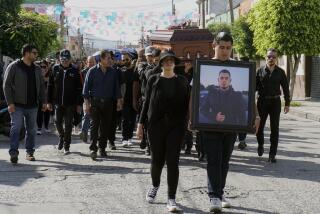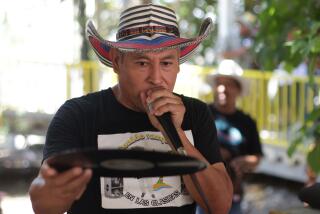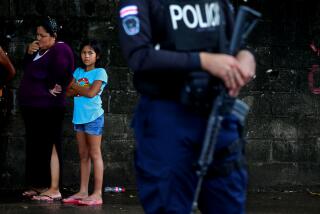Bolivia Town’s ‘Wild West’ Past Came to an End With Completion of New Highway
- Share via
SAN BORJA, Bolivia — When the sun sets and mosquitoes start buzzing in the dusty central square, talk often turns to the days before the motor vehicle tamed this prospering frontier town just a decade ago.
“They were the days of young blood, of hot blood,” recalls Eduardo Mejia, San Borja’s mayor. “Every man packed a pistol.”
The pistols were used enthusiastically, and the blood flowed in the rutted dirt streets. Most of the violence stemmed from a 15-year feud between two wealthy cattle-ranching families, the Tobiases and the Nogaleses, who lived at opposite corners of the square.
‘Insults’ Blamed
Nobody seems to recall exactly how many people died in the rivalry; perhaps a dozen or more. Nor do they recollect exactly what sparked it.
“Insults,” says Humberto Rea, president of the Town Council, with a shrug.
But it is agreed that the Nogales family suffered the worst of it, with two brothers gunned down in the square itself and the matriarch shot and gravely wounded as she stepped out of church. Finally, in the early 1970s, a peace was negotiated: The Nogaleses sold all their property to the Tobias clan and left.
In those days the only way to get to San Borja, founded in 1698 by Franciscan missionaries, was by foot, horseback or airplane. It was a roadless outpost, a cattle station with a law of its own.
Then, on Oct. 10, 1976, the highway east from the capital city of La Paz reached the community and changed life here forever.
The twisting, unpaved 245-mile highway descends from nearly three miles up in the Andean mountains to nearly sea level in the Beni, a Kansas-sized province of rain forest and savannah.
To travel its length takes 14 bouncing hours by jeep, along terrifyingly high cornices and through knee-deep mud. By bus, which now comes once a week to San Borja, it takes 20 hours. During the rainy season from December to April, it is impassable.
Down the new road 10 years ago came thousands of settlers who hacked, burned and cleared the jungle to create government-subsidized plantations of rice, plantains and citrus fruits. Many earn a living chopping down valuable hardwood trees, especially mahogany. Others set up small grocery and dry goods shops in San Borja itself.
Population Explosion
The town’s population ballooned from 4,000 to 15,000 or 20,000--it’s growing so quickly nobody can keep count.
“It’s disorganized growth,” complains Arnulfo Martinez, local representative of the state-run Beni Development Corp. “The urbanization isn’t following any plan.”
Public services, meager at best, have been overloaded. The town’s electrical generator broke down in June and remains unrepaired. Only the pink two-story hotel and a couple of other buildings with private generators enjoy an hour or two of electricity in the evening.
The settlers introduced a more conventional way of life. While horses still rule on the vast ranches on San Borja’s periphery, people now get about town in jeeps, small trucks and motorcycles. The only firearms seen on the streets now is the occasional bird rifle.
But a relatively new element has kept the area from being completely law-abiding: the temptations of big, easy money from drug trafficking.
The Beni is loaded with remote ranches converted into laboratories for processing coca from the Andean slopes into cocaine. Despite the presence of U.S. troops training local police, efforts to uncover the cocaine labs and arrest the big traffickers have met with limited success.
On a recent night, the town’s routine was happily disturbed by the arrival of three heavily armed U.S. Army Green Berets in a helicopter. One of the soldiers had broken a wrist falling off a horse and sought treatment from a local doctor.
The soldiers, in camouflage jungle garb, declined to chat with passers-by. “We don’t want to attract any crowds,” one said.
More to Read
Sign up for Essential California
The most important California stories and recommendations in your inbox every morning.
You may occasionally receive promotional content from the Los Angeles Times.












